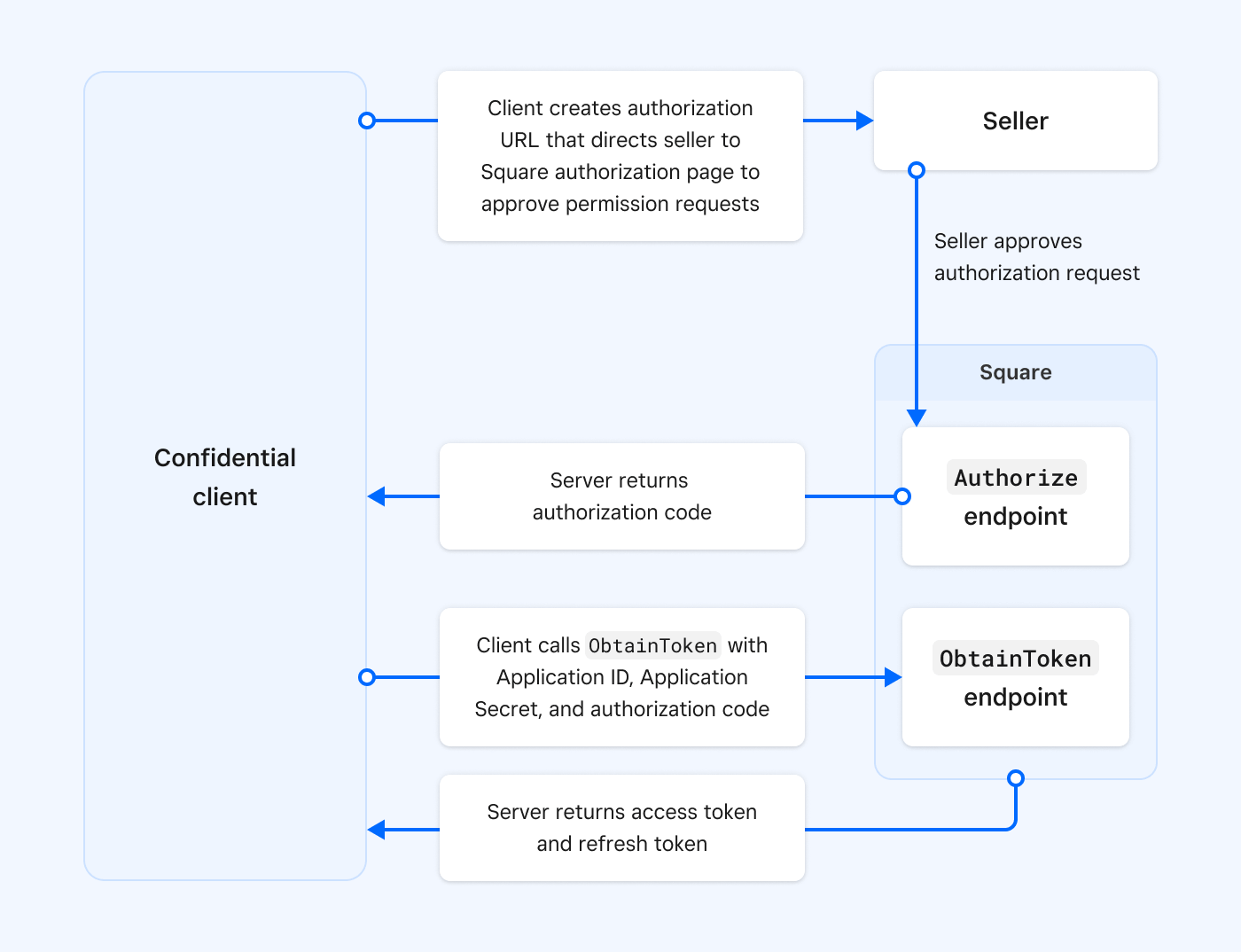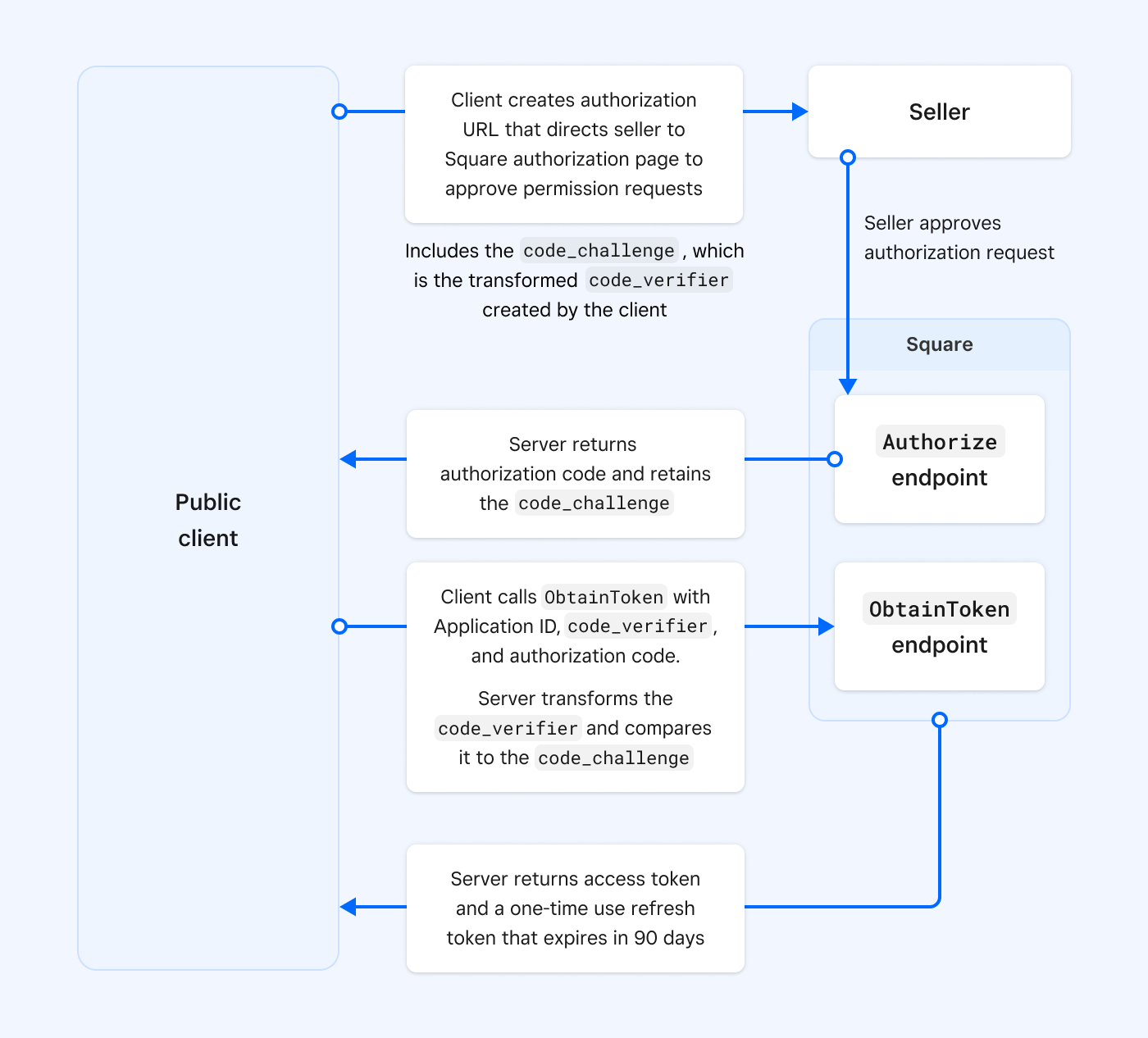Applies to: OAuth API
Use the OAuth API to connect your application to a seller's account using OAuth.
The Square OAuth API uses the OAuth 2 protocol to obtain permission from Square sellers to access specific types of resources in their account. During this process, client applications request specific permissions and receive an authorization code, which is then exchanged for an access token and refresh token. These tokens allow you to manage resources for a seller and call Square APIs on their behalf. Typically, the OAuth flow is initiated when onboarding a Square seller to your application.
The OAuth flow includes the following high-level stages:
| Stage 1: Authorization | Stage 2: Callback | Stage 3: Token request |
|---|---|---|
| Your application uses an authorization URL to send the seller to the Square authorization page where they can sign in to Square and grant the permissions you requested. | Square uses your redirect URL to send the seller back to your application and appends a code query parameter that contains an authorization code. | Your application calls ObtainToken and sends the authorization code, your application ID, and other fields. Square returns an access token and refresh token. |
The OAuth API requires HTTPS for the redirect URL for the authorization callback. For testing purposes using the Square Sandbox, you can use HTTP with localhost.
Authorization codes returned by the Square authorization page expire after 5 minutes. An authorization code can only be used once.
Square OAuth access tokens expire after 30 days. To maintain access, you must generate a new OAuth access token using the refresh token received with the original authorization. For more information about managing OAuth access tokens and refresh tokens, see OAuth API Best Practices.
Refresh tokens obtained using the code flow don't expire. Refresh tokens obtained using the PKCE flow are single-use tokens and expire after 90 days. If you lose a refresh token, you must repeat the full OAuth authorization flow to obtain a new OAuth access token and refresh token. A refresh token only becomes invalid when the application's access has been completely revoked.
A refresh token obtained using the code flow can be used to get multiple active access tokens. You can call ObtainToken multiple times with a refresh token. Each access token expires 30 days after it is obtained and each can be individually revoked. Developers sometimes choose to have multiple access tokens for a seller when the seller has a multi-store eCommerce site and wants a separate access token for each store.
Square offers two types of OAuth: a code flow and a PKCE (Proof Key for Code Exchange) flow:
The code flow is an OAuth flow that requires a confidential client to pass in the
client_idandclient_secretvalues when redeeming an authorization code from Square. Passing these types of sensitive data requires you to use a confidential client.The PKCE flow is an OAuth flow for public clients that removes the need to pass the
client_secretand replaces it with acode_verifier. Thecode_verifieris a unique string that the client application creates for every authorization request. The PKCE flow must be used by any client that cannot safely store secrets in the application, such as mobile applications, single-page applications, and native desktop applications.
Important
A confidential client is one where the application runs on a server and the seller interacts with the application by using a browser or an API. A public client, on the other hand, is a mobile or desktop application where the seller has the actual application on their device. Public clients shouldn't store secrets because the secret is stored inside the application and a debugger or disassembler can be used to find the secret.
The OAuth API uses the following OAuth terms when using the code flow or PKCE flow:
- Authorization code - A code that is returned when calling the
Authorizeendpoint. This code is used to redeem an access token and a refresh token. - Access token - A token that grants access to a client's resources and has some privileges attached to it. Access tokens expire after a certain amount of time.
- Refresh token - A token that is used to generate more access tokens. If you use the code flow, refresh tokens are valid until their access is revoked. If you use the PKCE flow, refresh tokens are single-use tokens and expire after 90 days.
Square doesn't support OpenID or other single sign-on (SSO) protocols on top of the OAuth implementation.
The OAuth code flow is designed for confidential client applications that run on a server and can store client information securely. The code flow uses the following OAuth terms:
client_id- The ID that is associated with an application using the OAuth process. This is a public variable and is called the Application ID in the Developer Console on the OAuth page.client_secret- The secret that is associated with an application. It is used to redeem refresh tokens and should never be shared by a public client. Leaking this information is equivalent to leaking a password. This variable is called the Application secret in the Developer Console on the OAuth page.
The code flow process is as follows:
- Your client application builds an authorization URL that you provide to the seller who approves the permissions you requested. The authorization URL contacts the
Authorizeendpoint. - The
Authorizeendpoint returns an authorization code by making aGETrequest to the redirect URL you registered for your application in the Developer Console. - The client calls the
ObtainTokenendpoint and provides the client ID, client secret, and the authorization code. - The
ObtainTokenendpoint returns an access token and a refresh token.

The OAuth PKCE flow is designed for public clients that shouldn't store secret information in their application. The PKCE process removes the need to pass the client_secret and doesn't require a secure backend server. The PKCE flow adds two new terms:
code_verifier- A unique random string generated by the client.code_challenge- A Base64-URL-encoded string of the SHA256 hash of thecode verifier.
The PKCE flow process is as follows:
- The client application builds an authorization URL that's the authorization request. The client application creates the
code_verifierand uses the Base64-URL-encoding of its SHA256 hash to create thecode_challenge. The authorization request calls theAuthorizeendpoint and includes thecode_challenge. You provide this URL to the seller who approves the permissions you request. - The
Authorizeendpoint returns an authorization code by making aGETrequest to the redirect URL you registered for your application in the Developer Console. The server retains thecode_challenge. - The client calls the
ObtainTokenendpoint and provides the client ID,code_verifier, and authorization code. The server verifies that thecode_verifieris the same value as the value that was encrypted to create thecode_challenge. - The
ObtainTokenendpoint returns an access token and a single-use refresh token that expires in 90 days.

If your application has a confidential client, one that is able to securely authenticate with an authorization server and is able to store the client_secret securely, you should use the OAuth code flow for your application. Using the OAuth code flow lets you receive multiple-use refresh tokens that don't expire.
If you have a public client that is unable to use registered client secrets or an application running in a browser or on a mobile device, you must use the OAuth PKCE flow. You should also choose the OAuth PKCE flow if you have a native desktop application, a single-page web application, or a mobile application. Refresh tokens expire after 90 days using the OAuth PKCE flow and you don't have to store the client_secret.
You can determine which OAuth flow to use by answering the following questions:
- Are you building a server application where you control the hosting? If yes, use the OAuth code flow.
- Are you building a single-purpose application where the application needs an access token? If yes, use the PKCE flow and use a short-lived token.
- Are you building a mobile application for installation on mobile devices around the world? If yes, use the PKCE flow and use a short-lived token.
Important
You cannot mix and match OAuth flows; you must choose either the code flow or the PKCE flow end to end.
To learn how to set up a basic website that uses the OAuth code flow, see OAuth Walkthrough: Test Authorization with a Web Server. For more information about writing authentication code, see OAuth Best Practices.
A webhook is a subscription that notifies you when a Square event occurs. For more information about using webhooks, see Square Webhooks.
The OAuth API supports the following webhook event:
| Event | Permission | Description |
|---|---|---|
| oauth.authorization.revoked | N/A | Notifies an application whenever a seller revokes all access tokens and refresh tokens granted to the application. |
If you use the OAuth API to get authorization to manage a seller's resources, you should create a webhook that notifies you of the oauth.authorization.revoked event. It indicates that a seller has removed your application's access to their resources. For a complete list of Square webhook events, see Webhook Events Reference.
Production is the live environment where Square sellers process real transactions and conduct business operations. The Square Sandbox is an isolated testing environment that developers can use to test integrations without affecting real users or data.
The base URL and application credentials must correspond to the target environment:
| Production | Sandbox | |
|---|---|---|
| Domain | squareup.com | squareupsandbox.com |
| OAuth API base URL | https://connect.squareup.com/oauth2 | https://connect.squareupsandbox.com/oauth2 |
| Example authorization URL | https://connect.squareup.com/oauth2/authorize?client_id=sq0idp-LJ1Sr4Iim0hGGvsMrx83&scope=ORDERS_READ+MERCHANT_PROFILE_READ&state=abc123 | https://connect.squareupsandbox.com/oauth2/authorize?client_id=sandbox-sq0idb-ioiyW39PwrXoGy4&scope=ORDERS_READ+MERCHANT_PROFILE_READ&state=abc123 |
Important
Make sure to provide sellers with the authorization URL for the production environment, which uses the production base URL and your production application ID. The Sandbox is only used for testing.
The tokens you obtain are also scoped to an environment. To call Square APIs (except the OAuth API), use the access token that corresponds to the base URL.
Calls to https://connect.squareup.com/v2 require a valid production access token.
curl https://connect.squareup.com/v2/locations \ -H 'Square-Version: 2025-01-23' \ -H 'Authorization: Bearer {PRODUCTION_ACCESS_TOKEN}' \ -H 'Content-Type: application/json'
Note
Webhook Subscriptions API and Events API endpoints require the developer's personal access token. OAuth access tokens aren't valid with these APIs.
Mixing the access token environment results in an AUTHENTICATION_ERROR error with the UNAUTHORIZED error code.
When testing the OAuth flow in the Sandbox, you cannot sign in directly to the Square authorization page like you can in the production environment.
Instead, you must open the Sandbox Square Dashboard for a Sandbox test account in a separate web page and then use the authorization URL to open the Square authorization page. For instructions, see step 3 in OAuth Walkthrough: Test Authorization with a Web Server. This limitation is the reason the session=false parameter in the authorization URL isn't supported in the Sandbox.
If you don't need to test the OAuth flow, you can create Sandbox test accounts and quickly generate Sandbox access tokens to test with specific permissions.
Authorization errors are typically caused by typos or mismatched credentials (Sandbox versus Production credentials).
- Make sure you've updated placeholders and default values in the sample code with valid application credentials.
- Make sure you've configured your credentials correctly. For example, if you're testing calls in production, make sure you're not using Sandbox credentials.
- Make sure you're using the right credential type. For example, application IDs are used for OAuth API calls but access tokens are often used in other API calls.
- Make sure the access token is sent as a bearer token (for example,
Authorization: Bearer {ACCESS_TOKEN}).
For more information, see Authentication errors.
- Create the Redirect URL and Square Authorization Page URL
- Receive Seller Authorization and Manage Seller OAuth Tokens
- Refresh, Revoke, and Limit the Scope of OAuth Tokens
- OAuth Walkthrough: Test Authorization with a Web Server
- OAuth Best Practices
- Move OAuth from the Sandbox to Production
- OAuth Permissions Reference
- Video: OAuth Best Practices